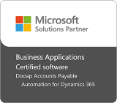
As we ring in the new year, it’s time to take stock of 2018 and even more importantly, look ahead to what we can expect this year. In some ways, AP professionals will be more in the driver’s seat as they look for solutions that increase usability and deliver a higher level of automation. At the same time, technology providers will deliver solutions that offer more advanced capabilities to meet growing user demands.
Here are five key AP trends we can expect to see this year:
Increasing interest in best-in-class AP systems
Many AP departments have swapped their manual processes for automated ones and have realized the benefits of automation, including streamlined processes, increased efficiencies and reduced costs. A growing number of these companies have outgrown the more basic AP capabilities that ERP solutions offer and instead are turning to best-in-class solutions that were developed from the ground up to achieve greater automation results. In particular, as companies look for technologies that are intuitive and easy to use, offer greater transparency and provide a higher level of automation, they are increasingly turning to best-in-class solutions that can deliver this.
Get prepared for the Dynamics 365 new upgrade process
We predicted last year that Dynamics 365 would be on the uptick, and that trend, which came to pass, is expected to continue this year as well. In addition, there’s an interesting change that will be hitting the Dynamics 365 world this year: unlike other areas, when it comes to upgrades, control is moving away from the user to Microsoft. Differing from previous years when users could determine their own upgrade path and timeframe for updates, beginning this year, upgrades to the cloud version will be mandatory, so that everyone will be on the same version.
Users will have until April 19 to upgrade their system and afterwards they are expected to conduct monthly upgrades as Microsoft issues continual updates. Under the new process they won’t be allowed to fall more than three months behind on an update. This means that companies need to plan ahead, determining how they will handle testing and system downtime for customizations and add-ons. Companies using an AP Automation solution like Dooap benefit from seamless D365 updates, which won’t impact the AP system and require minimal IT involvement.
Mobile continues to rule
Convenience continues to be a critical capability of B2B apps, and AP automation is no different. Last year we predicted that AP tools will become more app-like, making them as intuitive and easy-to-use as consumer apps. That has certainly proven true and this year we expect greater focus on mobile apps to support AP professionals, as well as reviewers and approvers anytime and anywhere. In addition to increased efficiencies, these apps speed up processing and reduce the number of vendor inquiries, which in turn decreases the time that AP professionals need to focus on that task.
Robots and AI are making processes streamlined and smarter
Last year we predicted that software robotics and machine learning would take hold and that was certainly the case. Adoption of Robotic Process Automation (RPA) technology really took off, especially for AP, Finance and customer service departments. RPA, a rules-based software that handles manual, repeatable tasks, provides an easy way for companies to gain process efficiencies. It can be used in AP to validate invoices, complete coding and fill in invoice data fields.
This year we will see a growing use of artificial intelligence (AI) in AP, as it moves from the early adopter stage and is embraced by more mid-sized organizations. AI apps, which are able to teach themselves rules based on previous transactions, can be used to determine the appropriate routing of invoices, handle coding of non-PO-based invoices, and conduct analytics, among other tasks. The self-teaching apps rely on a lot of high-quality, accurate data, making that a key area of focus for organizations this year, which was also a key theme at IOFM Conference last November. As RPA, AI and process automation software become more popular in organizations, AP staff will have more time to focus on analytical tasks such as spend analysis, payment timing and more.
E-invoicing continues to gain ground
Our 2018 predictions for 2018 that e-invoicing was in and OCR is out, was spot on. There is less interest in OCR, although OCR-as-a-Service is gaining ground as a middle approach to more effectively deal with the paper invoices that are out there.
On another front, the EU is moving full steam ahead on standardizing e-invoicing in the public sector, laying the groundwork for the directive requiring all invoices in the sector to be received electronically by April 18 of this year. The impetus behind this effort is to help organizations automate financial management and cut costs.
Under the auspices of the Federal Reserve, the U.S. has been working on trying to create a framework for e-invoicing with the hopes of generating interest from the private as well as public sector. Dooap is involved in the Semantic Group of the Reserve’s Business Payments Coalition, with a focus on defining the content and format of e-invoices, using the model published by the EU in 2017 as well as the Australian one.
Most 2018 trends continue in 2019
In addition to the above trends, there are other predictions from last year that we expect to continue to have an impact in 2019. Our prediction that visibility and control will result in influence, is one that is continuing to unfold in AP departments across the country. As more information and insight can be gleaned from invoices, AP is in a position to give CFOs valuable information on spend to help optimize vendor payment plans, payment schedules and working capital management. Similarly, this visibility will further last year’s prediction that the silos between AP and Procurement will break down, enable greater collaboration and helping Procurement make more strategic decisions on product expansion, inventory capacity and vendor selection.
Last year’s prediction that chatbots will become more integrated in expense management, with the availability of natural language capabilities from services like Microsoft Azure’s LUIS (Language Understanding Intelligent Service), is currently underway. As this becomes more prevalent, mobile workers can capture travel expenses and billable hours in real time, enabling AP to be more efficient.
AP automation has made great strides over the past year, both in terms of technological advances and adoption. This year we expect greater penetration of RPA and AI technologies; progress in e-invoicing; and a focus on advanced, easy-to-use solutions developed from the ground up to provide the type of mobility, ease-of use and convenience that B2B users want and need; among other exciting trends. What are you doing to advance your AP practices this year?
What is AP Automation?
We've gathered everything you need to know about Accounts Payable Automation on one page. If you're ready to learn, just click the button below!








